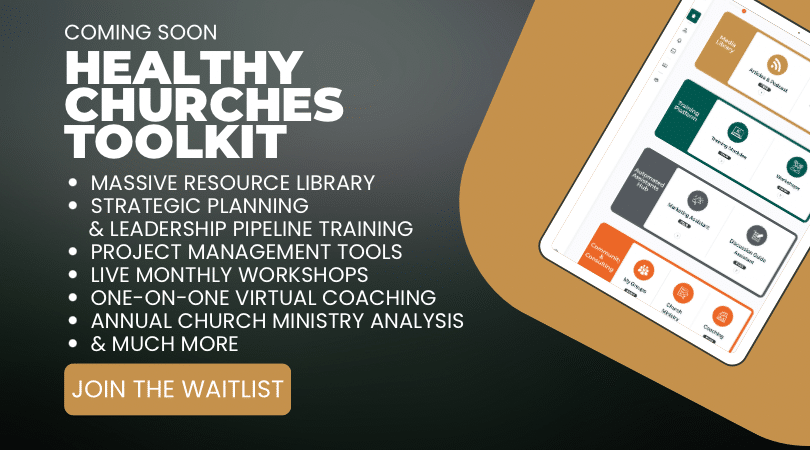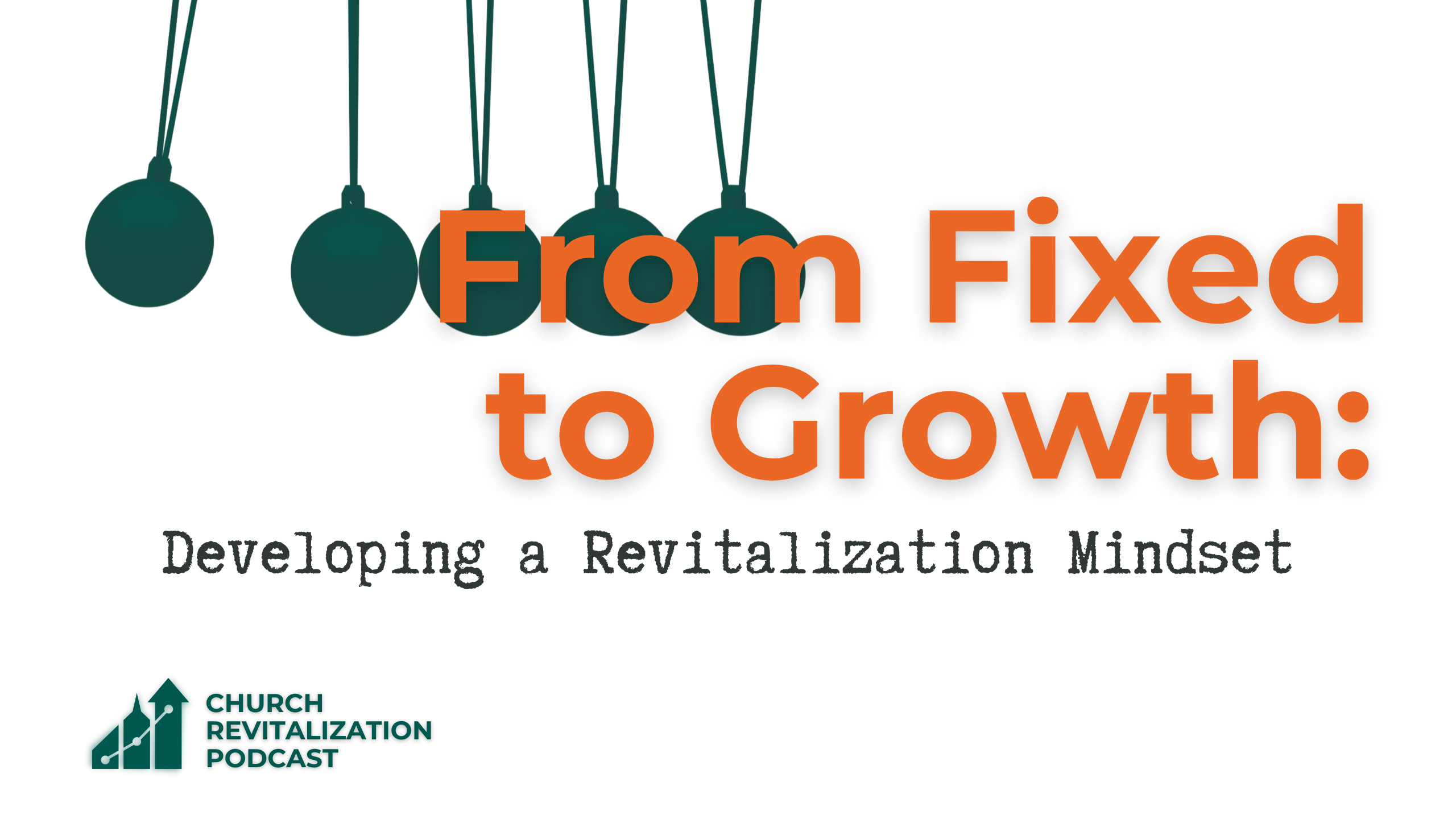The Church Revitalization Podcast – Episode 203
If you’ve ever tried to get a stalled car rolling downhill, you know it takes immense effort just to get the thing moving. But once you’ve broken through that initial inertia, momentum takes over and the car practically rolls itself.
I see churches like stalled cars in this regard. Initial change is the hardest – overcoming traditions, mindsets, and “that’s how we’ve always done it” attitudes. But when your church gains traction in its revitalization efforts, momentum works towards your advantage. Growth breeds more growth. Energy begets more energy. Done right, your church can go from stagnant to thriving.
But how do you start that momentum to begin with? In this article, I’ll share practical ideas to shift your church from a fixed mindset to a growth mindset.
Subscribe below to never miss an episode.
Defining Fixed vs. Growth Mindsets
First, what do I mean by “fixed” and “growth” mindsets?
A fixed mindset assumes abilities and intelligence are static. You have innate natural talents (or you don’t), and not much changes over time. It’s a deterministic perspective that sees obstacles as insurmountable barriers. A fixed mindset says, “it is what it is.”
In contrast, a growth mindset believes talents can be developed incrementally through practice. Obstacles become opportunities to learn. Failures teach rather than discourage. There’s an underlying optimism that keeps striving.
A growth mindset sees our intelligence and abilities can be developed over time through effort. We’re not limited by innate wiring. God can transform us.
Without a growth mindset, genuine church revitalization is virtually impossible. When you run up against inevitable challenges and setbacks, a fixed mindset will induce paralysis. It restricts your imagination of what’s possible.
Cultivating a growth mindset, on the other hand, empowers your church to adapt and progress. Let’s explore some ideas to make that shift.
Confront Reality, Then Respond
A growth mindset isn’t naively optimistic. It confronts reality head-on. Problems and challenges are real – you can’t ignore them. A church in decline or facing conflict can’t just play pretend.
However, a growth mindset responds to reality in a constructive way. It asks what opportunities exist within the circumstances. How can we leverage strengths and assets? What first steps will build momentum?
It’s not until after Jesus’ disciples respond to the command to feed the 5000 and start passing out the little food that they do have that they then realize that they have more than enough.
Even with meager resources, taking initiative unlocks potential. A growth mindset pursues solutions, not excuses.
Replace Excuses With Effort
A fixed mindset obsesses over why change isn’t possible: We’re landlocked, our facilities are inadequate, we don’t have enough young families, etc.
But are these genuine barriers or merely excuses? More often than not, excuses justify inaction. They let us remain in our comfort zones.
The real shortage isn’t money, talent, or resources. It’s effort. Many churches simply exchange routine for real exertion outside their norms. A growth mindset, in contrast, makes every effort to supplement faith with virtues like perseverance and love (see 2 Peter 1:5-8).
Revitalization doesn’t happen without good planning and work and preparation and prayer and perseverance. But it requires effort. Effort expands your possibilities. Excuses constrain them.
Channel Frustration into Vision
A growth mindset reframes frustration as fuel for the future. In the last couple of years, I worked with a church in Delaware that nearly closed after years of decline. But in one year of revitalization work, the mood shifted from despair to hope. Small changes compounded, from consistent neighborhood outreach to updating dysfunctional governance policies.
The reality was difficult, but the pastor channeled frustration into a God-inspired vision. Creativity and effort followed. Progress compounded and led to encouragement.
Many churches languish in a kind of resigned disappointment. And with good reason – declining attendance, rising conflicts, and aging facilities are genuinely disheartening. Grieving is appropriate. But getting stuck there neuters your church.
A growth mindset moves through grief into vision. It translates discouragement into a catalyst for change. The worst thing your church can do is spiritually hold its breath waiting for death. Breathe in vision and purpose instead.
Celebrate Small Wins
Big, overnight success is rare during church revitalization. Far more common are small but cumulative victories. A few additional young families visiting. New community partnerships. A growing sense of hope among the congregation.
A growth mindset celebrates these small wins. It tracks and appreciates incremental progress, which sustains momentum over the long haul. Quick “silver bullet” fixes may grab attention, but real change comes from doing the right thing, the right way for a long time.
When revitalization gains traction, it’s like pushing that stubborn car over the initial hump. Repetition and persistence pay dividends. A growth mindset recognizes that real-world change mirrors sanctification – it’s a lifelong journey of slight course corrections and closer approximations of godliness.
As you cultivate a growth mindset in your church, take time in leadership meetings and worship services to highlight modest improvements. Make sure stories of “quick wins” spread virally. Leverage small victories to fuel bigger ones.
Experiment Through Small Risks
Many churches default to paralysis by analysis. They research and strategize but rarely pull the trigger on anything. Six months goes by with little tangible movement.
A growth mindset takes a different approach: quick small bets. Try something new without overanalyzing. It may work or it may not, but either way you gain key learnings. Do more of what shows promise, and tweak or abandon what doesn’t.
Run small experiments that can safely fail without huge consequences. This might look like a new social media outreach campaign, reconfiguring the lobby, or testing some changes to your community life strategy.
Not everything will produce results, but bumps are learning moments. Through small risks, you determine what gains traction. Over time, cumulative small wins amount to exponential change.
Ask Empowering Questions
Fixed mindset questions often begin with “Why can’t we…?” This frames obstacles as intractable and deflates hope.
Empowering questions start with possibility: “How could we…?” or “What if…?” They invite creativity, effort, and the collaborative realization of vision.
Does your church obsess over restricting factors, or do you lead it to imagine potential? Questions steer thinking, so phrase them constructively. If “why can’t we grow?” prompts discouragement, reframe it: “How could we better reach young families in our area?” That kickstarts solutions.
Remember that leadership sets the tone.
Mindsets flow downhill. If the pastor and leadership team embodies a fixed mindset, complaining about limitations or resisting innovation, it infects the whole church.
The opposite also holds true. When leaders model a growth mindset – praising effort, highlighting progress, facing reality with resilience – it uplifts the congregation.
If you sense your church has a fixed mindset, reframing leadership’s outlook is the first priority. Have candid conversations as a leadership team. Study growth mindset concepts together. Set the expectation that elders and staff will exemplify a positive, empowering posture. Change begins with leadership.
View Obstacles as Opportunities
A huge indicator of fixed versus growth mindset is how someone responds to difficulties and setbacks. Leaders with a fixed mindset see obstacles as discouraging signs. Their energy deflates. Progress seems impossible in the face of challenges.
With a growth mindset, obstacles become opportunities for improvement. Each challenge carries important lessons to apply moving forward. Rather than eroding enthusiasm, setbacks are channels for development.
I regularly work with small, aging churches that have repeatedly failed to connect with young families in their community. Their initial attitude is that outreach to millennials is hopeless – “they just aren’t interested in church.”
But you need to reframe this as an opportunity to learn. Study thriving churches that attract young families. Survey community members about impressions of your church. Experimented with new types of outreach events.
Early attempts may flop. A fixed mindset triggers shame and paralysis. Instead, keep tweaking your approach based on feedback.
By viewing a lack of young families as an opportunity rather than an obstacle, your church can identify a need to fill. The path may involve failures, but each one teaches you something. Persistence paired with a growth mindset reveals the solution.
When you run up against limitations, results may not come quickly. But resisting the temptation to wallow in discouragement keeps you striving prayerfully toward breakthroughs. Remember that setbacks are simply stepping stones toward fruitfulness in God’s timing.
The growth mindset concepts touched on above – whether confronting reality courageously, replacing excuses with effort, or viewing obstacles as opportunities – set up a church for revitalization.
Without this mindset shift, churches float on autopilot. Decline feels inevitable because a fixed mindset can’t envision anything else. Talk of growth seems absurd.
But when a church embraces a growth mindset, the impossible becomes possible. New potential takes shape with each small step up the mountain. Progress builds on itself organically.
No single switch flips. The flywheel turns slowly at first. But a growth mindset and genuine effort align to create momentum. God honors a church moving in faith, even if that only means inching forward.
So take that first step. Start the upward trajectory. Dislodge the stalled car and get it rolling downhill. The steepest climb is right in front of you. With consistent effort and God’s blessing, gravity will soon take over.
BONUS: Watch this episode on YouTube.


Scott Ball is the Vice President and a Lead Guide with The Malphurs Group. He lives in East Tennessee with his wife and two children. (Email Scott).

